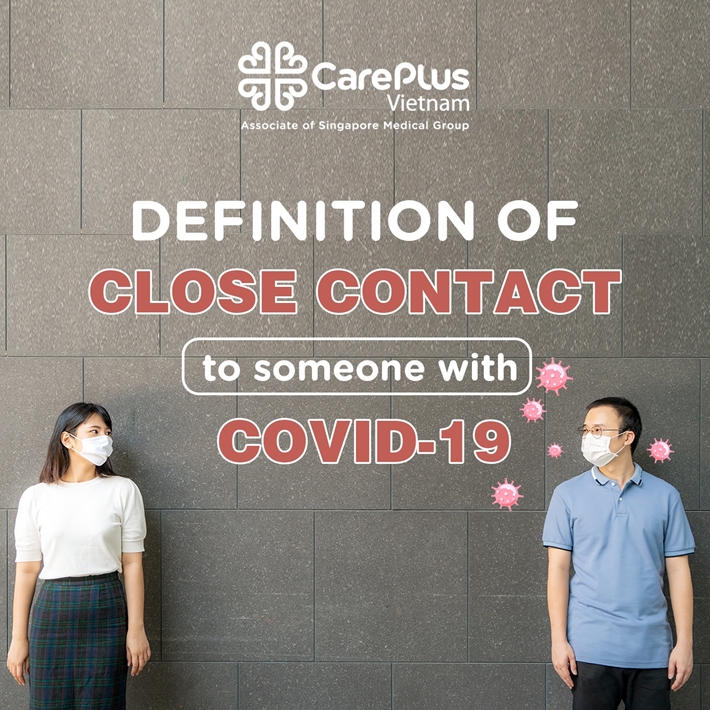Definition of "close contact" to someone with COVID-19
Below is Dr Phung Ngoc Minh Tan's article; please provide all staff with the proper knowledge to take the right actions and attitudes during the epidemic period.

7/29/2021 11:31:05 AM
During the current pandemic, receiving news that a relative, colleague, or friend is suspected of being infected with Covid-19 can cause a lot of anxiety for you and your family. Many brothers and sisters have asked and consulted doctors about wondering if I am F1, what is Close Contact, if I am at high risk of being infected, etc.
Close contact with F0 is the basis for determining F1, especially in epidemic areas. In addition, the current regulation also divides F1 into close F1 and far F1 to manage isolation. State agencies decide this division based on the level of contact of each specific case.
So I would like to share with you a few short notes and some real-life examples of Close Exposure. Hope everyone has more information for individuals and family members, so that from the proper awareness will have the right attitude and action in the current situation.
According to the US CDC, close contact is defined as cases occurring within 48 hours before the sick person begins to have symptoms (cough, fever, ...) or before a positive result (if F0 is not present). Symptom). It could be the following activities:
- Contact with sick people within a distance of 2 meters. Total contact time > 15 minutes (multiple exposures, e.g. three times, 5 minutes each, still count as close contact)
- Contacting an infected person within a distance of less than 1 meter is considered high risk (regardless of contact time).
- Direct contact with the sick person (e.g. hug, shoulder, handshake)
- Direct contact with respiratory secretions of the sick person (coughing, sneezing, tissue with secretions, sharing cups, face towels or other personal hygiene items)
- Living in the same house as the sick person
- Same working group / same room with the patient
- Travel with groups, work, meet, have fun with patients
- Sit within the same row of seats or before/after two rows of seats with the case
Of course, close contact does not mean that you will get Covid-19. Factors such as contact environment (open air will be less contagious than in closed rooms), personal protective equipment (medical masks, droplet shields), the amount of virus in the patient have a significant influence risk of infection.
Risk classification Proximal exposure is as follows.
- High risk: do not use or use less than 1 of 2 types (medical mask/drop shield
- Low risk: use two forms of protection or pass the patient in a split second.
Here are a few real-life case examples to better understand close contact:
- High risk: do not use or use less than 1 of 2 types (medical mask/drop shield
- Low risk: use two forms of protection or pass the patient in a split second.
Here are a few real-life case examples to better understand close contact:
Example 1: You and your colleague meet in the front yard of the building, both wearing medical masks. You two stand close to each other < 2 m. The next day, colleagues reported test results (+)
→ It can be close contact if you shake hands or put your shoulder on, or a colleague accidentally sneezes when you stand near, or the two of you talk for > 15 minutes. If you accidentally met in front of the yard, waved goodbye and left immediately, although this may be close contact, it is low risk because the contact time is concise, the two of you are outdoors.
Example 2: You work in an office, wear a medical mask and a drop shield, always keep a distance of > 2 m from others. Suddenly someone from the same company but in another department got results (+)
→ This case is not in close contact if you follow the above correctly.
Example 3: Your co-workers often come into your office several times a day to chat. Today he tested (+)
→ It could be close contact. It is not necessary to talk for 15 minutes to be considered close contact. When you speak 2-3 minutes each time, 5-6 times a day, it is possible to reach a total of > 15 minutes, considered contact near the.
Example 4: You and a colleague have lunch. One person brings a large cup of milk tea and invites everyone to share. Each person comes and pours from the shared glass of water into their glass. The next day you have a fever, get tested (+)
→ Members sharing a glass of water are considered close contact. It is not because the virus is transmitted through eating, but it is possible that the secretions on the surface of the glass will be the source of infection, especially when the contact touches the face (eyes, nose, mouth)
Example 5: You and your colleague share a bus for business. You sit at the front of the car, your colleagues sit at the back of the vehicle, both of them wear medical masks as well as splash screens. The driver did not turn on the air conditioner but opened all the windows on the car. The next day colleagues test (+)
→ You are not considered close contact because of the distance > 2 meters, complete protective equipment, in addition to being continuously ventilated to the outside, so the risk is shallow.
In summary, understanding the nature and being alert about possible close contact plays a vital role in minimizing the possibility of infecting yourself and those around you. Complying with the principle of a safe distance of > 2m, wearing proper protective equipment, not sharing personal items are practical daily activities that need to be maintained so that even when in close contact with an unintentionally, you are still in the low-risk category of immediate contact.